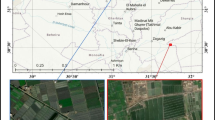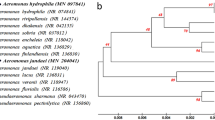Abstract
Tilapia lake virus (TiLV) is a serious pathogen of farmed Nile tilapia (Oreochromis niloticus) responsible for significant mortalities. In this study, we investigated a disease outbreak in cage-farmed Nile tilapia in India. The infected fish exhibited clinical signs such as severe scale loss, haemorrhage, exophthalmia, and fin and tail rot. The samples were screened for Tilapia lake virus (TiLV) by reverse-transcriptase PCR and also subjected to detailed bacteriological investigation to understand the association between TiLV and co-infecting bacterial pathogens. Bacteria were isolated from TiLV-infected and apparently healthy fish, and identified by conventional microbiological methods, followed by 16SrRNA gene sequencing. TiLV was detected by PCR in all the samples exhibiting clinical signs, while apparently healthy fish were negative for the virus. A total of 34 bacterial isolates belonging to the genera Aeromonas, Staphylococcus, Enterococcus, Plesiomonas, Enterobacter, Bacillus, Lysinibacillus, Solibacillus and Exiguobacterium were isolated from the virus-infected tilapia. However, Aeromonas veronii was found to be the most dominant bacterium isolated from the surface lesions and the internal organs of all infected fish. Antibiotic susceptibility testing revealed that A. veronii, by far, was susceptible to cephalosporins (ceftriaxone, cefotaxime, cefpodoxime), chloramphenicol, aminoglycosides (amikacin, gentamicin), ciprofloxacin and chloramphenicol. Experimental infection using intraperitoneally injected A. veronii reproduced the clinical signs of naturally infected Nile tilapia, and a lethal dose 50 (LD50) mortality was observed by day 7 post-challenge. Furthermore, A. veronii could be re-isolated from the experimentally infected fish. Based on this evidence, we propose that virulent A. veronii as a co-infecting bacterium can have an important role in the severity and outcome of the disease in Nile tilapia infected by TiLV.




Similar content being viewed by others
References
Abbott SL, Cheung WK, Janda JM (2003) The genus Aeromonas: biochemical characteristics, atypical reactions, and phenotypic identification schemes. J Clin Microbiol 41:2348–2357. https://doi.org/10.1128/jcm.41.6.2348-2357.2003
Abdel-Latif HMR, Khafaga AF (2020) Natural co-infection of cultured Nile tilapia Oreochromis niloticus with Aeromonas hydrophila and Gyrodactylus cichlidarum experiencing high mortality during summer. Aquac Res 51:1880–1892. https://doi.org/10.1111/are.14538
Abdel-Latif HMR, Dawood MAO, Menanteau-Ledouble S, El-Matbouli M (2020) The nature and consequences of co-infections in tilapia: a review. J Fish Dis 43:651–664. https://doi.org/10.1111/jfd.13164
Abu-Elala N, Abdelsalam M, Marouf S, Setta A (2015) Comparative analysis of virulence genes, antibiotic resistance and gyrB-based phylogeny of motile Aeromonas species isolates from Nile tilapia and domestic fowl. Lett Appl Microbiol 61:429–436. https://doi.org/10.1111/lam.12484
Alizon S, de Roode JC, Michalakis Y (2013) Multiple infections and the evolution of virulence. Ecol Lett 16:556–567. https://doi.org/10.1111/ele.12076
Amal MNA, Koh CB, Nurliyana M, Suhaiba M, Nor-Amalina Z, Santha S, Diyana-Nadhirah KP, Yusof MT, Ina-Salwany MY, Zamri-Saad M (2018) A case of natural co-infection of tilapia lake virus and Aeromonas veronii in a Malaysian red hybrid tilapia (Oreochromis niloticus×O. mossambicus) farm experiencing high mortality. Aquaculture 485:12–16. https://doi.org/10.1016/j.aquaculture.2017.11.019
Austin B, Austin DA (2016) Aeromonadaceae representatives (motile Aeromonads). In: Austin B, Austin DA (eds) Bacterial fish pathogens: disease of farmed and wild fish. Springer International Publishing, Cham, pp 161–214
Azad I, Rajendran KV, Rajan JJS, Vijayan KK, Santiago TC (2001) Virulence and histopathology of Aeromonas hydrophila (SAH 93) in experimentally infected tilapia, Oreochromis mossambicus (L.). J Aquac Tropics 16:265–275
Bacharach E, Mishra N, Briese T et al (2016) Characterization of a novel orthomyxo-like virus causing mass die-offs of tilapia. mBio 7:e00431–e00416. https://doi.org/10.1128/mBio.00431-16
Behera BK, Pradhan PK, Swaminathan TR, Sood N, Paria P, Das A, Verma DK, Kumar R, Yadav MK, Dev AK, Parida PK, Das BK, Lal KK, Jena JK (2018) Emergence of tilapia lake virus associated with mortalities of farmed nile tilapia Oreochromis niloticus (Linnaeus 1758) in India. Aquaculture 484:168–174. https://doi.org/10.1016/j.aquaculture.2017.11.025
Chandrarathna HPSU, Nikapitiya C, Dananjaya SHS, Wijerathne CUB, Wimalasena SHMP, Kwun HJ, Heo GJ, Lee J, de Zoysa M (2018) Outcome of co-infection with opportunistic and multidrug resistant Aeromonas hydrophila and A. veronii in zebrafish: identification, characterization, pathogenicity and immune responses. Fish Shellfish Immunol 80:573–581. https://doi.org/10.1016/j.fsi.2018.06.049
CLSI (2018) CLSI. Performance standards for antimicrobial susceptibility testing. 28th ed. CLSI supplement M100. Clinical and Laboratory Standards Institute, Wayne
Dong HT, LaFrentz B, Pirarat N, Rodkhum C (2015) Phenotypic characterization and genetic diversity of Flavobacterium columnare isolated from red tilapia, Oreochromis sp., in Thailand. J Fish Dis 38:901–913. https://doi.org/10.1111/jfd.12304
Dong HT, Siriroob S, Meemetta W, Santimanawong W, Gangnonngiw W, Pirarat N, Khunrae P, Rattanarojpong T, Vanichviriyakit R, Senapin S (2017a) Emergence of tilapia lake virus in Thailand and an alternative semi-nested RT-PCR for detection. Aquaculture 476:111–118. https://doi.org/10.1016/j.aquaculture.2017.04.019
Dong HT, Techatanakitarnan C, Jindakittikul P, Thaiprayoon A, Taengphu S, Charoensapsri W, Khunrae P, Rattanarojpong T, Senapin S (2017b) Aeromonas jandaei and Aeromonas veronii caused disease and mortality in Nile tilapia, Oreochromis niloticus (L.). J Fish Dis 40:1395–1403. https://doi.org/10.1111/jfd.12617
El-Son MAM, Nofal MI, Abdel-Latif HMR (2021) Co-infection of Aeromonas hydrophila and Vibrio parahaemolyticus isolated from diseased farmed striped mullet (Mugil cephalus) in Manzala, Egypt – a case report. Aquaculture 530:2021,735738. https://doi.org/10.1016/j.aquaculture.2020.735738
Eyngor M, Zamostiano R, Kembou Tsofack JE, Berkowitz A, Bercovier H, Tinman S, Lev M, Hurvitz A, Galeotti M, Bacharach E, Eldar A (2014) Identification of a novel RNA virus lethal to tilapia. J Clin Microbiol 52:4137–4146. https://doi.org/10.1128/JCM.00827-14
FAO (2005) Cultured aquatic species information programme. Oreochromis niloticus. Cultured aquatic species information programme. Text by Rakocy, J. E. In: FAO Fisheries and Aquaculture Department [online]. Rome. Updated 18 February 2005
Fathi M, Dickson C, Dickson M, Leschen W, Baily J, Muir F, Ulrich K, Weidmann M (2017) Identification of tilapia lake virus in Egypt in Nile tilapia affected by ‘summer mortality’ syndrome. Aquaculture 473:430–432. https://doi.org/10.1016/j.aquaculture.2017.03.014
Ferguson HW, Kabuusu R, Beltran S, Reyes E, Lince JA, del Pozo J (2014) Syncytial hepatitis of farmed tilapia, Oreochromis niloticus (L.): a case report. J Fish Dis 37:583–589. https://doi.org/10.1111/jfd.12142
Figueiredo HCP, Klesius PH, Arias CR, Evans J, Shoemaker CA, Pereira DJ, Peixoto MTD (2005) Isolation and characterization of strains of Flavobacterium columnare from Brazil. J Fish Dis 28:199–204. https://doi.org/10.1111/j.1365-2761.2005.00616.x
Hassan MA, Noureldin EA, Mahmoud MA, Fita NA (2017) Molecular identification and epizootiology of Aeromonas veronii infection among farmed Oreochromis niloticus in Eastern Province, KSA. Egypt J Aquat Res 43:161–167. https://doi.org/10.1016/j.ejar.2017.06.001
Jansen MD, Dong HT, Mohan CV (2019) Tilapia lake virus: a threat to the global tilapia industry? Rev Aquac 11:725–739. https://doi.org/10.1111/raq.12254
Kembou Tsofack JE, Zamostiano R, Watted S, Berkowitz A, Rosenbluth E, Mishra N, Briese T, Lipkin WI, Kabuusu RM, Ferguson H, del Pozo J, Eldar A, Bacharach E (2017) Detection of tilapia lake virus in clinical samples by culturing and nested reverse transcription-PCR. J Clin Microbiol 55:759–767. https://doi.org/10.1128/JCM.01808-16
Kinnula H, Mappes J, Sundberg L-R (2017) Coinfection outcome in an opportunistic pathogen depends on the inter-strain interactions. BMC Evol Biol 17:77. https://doi.org/10.1186/s12862-017-0922-2
Kobayashi M, Msangi S, Batka M, Vannuccini S, Dey MM, Anderson JL (2015) Fish to 2030: the role and opportunity for aquaculture. Aquac Econ Manag 19:282–300. https://doi.org/10.1080/13657305.2015.994240
Kotob MH, Menanteau-Ledouble S, Kumar G, Abdelzaher M, el-Matbouli M (2016) The impact of co-infections on fish: a review. Vet Res 47:98. https://doi.org/10.1186/s13567-016-0383-4
Krumperman PH (1983) Multiple antibiotic resistance indexing of Escherichia coli to identify high-risk sources of fecal contamination of foods. Appl Environ Microbiol 46:165–170
Kuhn JH, Wolf YI, Krupovic M, Zhang YZ, Maes P, Dolja VV, Koonin EV (2019) Classify viruses — the gain is worth the pain. Nature 566:318–320. https://doi.org/10.1038/d41586-019-00599-8
Lane DJ (1991) 16S/23S rRNA sequencing. In: Stackebrandt E,. Goodfellow M (eds) Nucleic acid techniques in bacterial systematics. John Wiley & Sons, New York, pp 115–175.
Li Y, Cai S-H (2011) Identification and pathogenicity of Aeromonas sobria on tail-rot disease in juvenile tilapia Oreochromis niloticus. Curr Microbiol 62:623–627. https://doi.org/10.1007/s00284-010-9753-8
Liu C, Chang OQ, Zhang DF, Li KB, Wang F, Lin MH, Shi CB, Jiang L, Wang Q, Bergmann SM (2018) Aeromonas shuberti as a cause of multi-organ necrosis in internal organs of Nile tilapia, Oreochromis niloticus. J Fish Dis 41:1529–1538. https://doi.org/10.1111/jfd.12848
Menaga M, Fitzsimmons K (2017) Growth of tilapia industry in India. World Aquac 48(3):49–52
Nguyen VV, Dong HT, Senapin S, Pirarat N, Rodkhum C (2016) Francisella noatunensis subsp. orientalis, an emerging bacterial pathogen affecting cultured red tilapia (Oreochromis sp.) in Thailand. Aquac Res 47:3697–3702. https://doi.org/10.1111/are.12802
Nicholson P, Fathi MA, Fischer A, Mohan C, Schieck E, Mishra N, Heinimann A, Frey J, Wieland B, Jores J (2017) Detection of tilapia lake virus in Egyptian fish farms experiencing high mortalities in 2015. J Fish Dis 40:1925–1928. https://doi.org/10.1111/jfd.12650
Osman KM, Al-Maary KS, Mubarak AS et al (2017) Characterization and susceptibility of streptococci and enterococci isolated from Nile tilapia (Oreochromis niloticus) showing septicaemia in aquaculture and wild sites in Egypt. BMC Vet Res 13:357. https://doi.org/10.1186/s12917-017-1289-8
Plumb JA, Hanson LA (2011) Tilapia bacterial diseases. In: Health maintenance and principal microbial diseases of cultured fishes. 3rd Edition, Wiley-Blackwell, Ames, Iowa, pp 445–463
Pradeep PJ, Suebsing R, Sirithammajak S, Kampeera J, Turner W, Jeffs A, Kiatpathomchai W, Withyachumanarnkul B (2017) Vertical transmission and concurrent infection of multiple bacterial pathogens in naturally infected red tilapia (Oreochromis spp.). Aquac Res 48:2706–2717. https://doi.org/10.1111/are.13102
Raj NS, Swaminathan TR, Dharmaratnam A et al (2019) Aeromonas veronii caused bilateral exophthalmia and mass mortality in cultured Nile tilapia, Oreochromis niloticus (L.) in India. Aquaculture 512:734278. https://doi.org/10.1016/j.aquaculture.2019.734278
Ran C, Qin C, Xie M, Zhang J, Li J, Xie Y, Wang Y, Li S, Liu L, Fu X, Lin Q, Li N, Liles MR, Zhou Z (2018) Aeromonas veronii and aerolysin are important for the pathogenesis of motile aeromonad septicemia in cyprinid fish. Environ Microbiol 20:3442–3456. https://doi.org/10.1111/1462-2920.14390
Reed LJ, Muench H (1938) A simple method of estimating fifty per cent endpoints. Am J Epidemiol 27:493–497. https://doi.org/10.1093/oxfordjournals.aje.a118408
Senapin S, Phiwsaiya K, Gangnonngiw W, Briggs M, Sithigorngul P, Flegel TW (2013) Dual infections of IMNV and MrNV in cultivated Penaeus vannamei from Indonesia. Aquaculture 372–375:70–73. https://doi.org/10.1016/j.aquaculture.2012.10.027
Sood N, Pradhan PK, Ravindra et al (2020) Large-scale mortality in cultured tilapia Oreochromis niloticus due to infection with Shewanella putrefaciens in India. J World Aquac Soc 51:563–570. https://doi.org/10.1111/jwas.12686
Soto E, Hawke JP, Fernandez D, Morales JA (2009) Francisella sp., an emerging pathogen of tilapia, Oreochromis niloticus (L.), in Costa Rica. J Fish Dis 32:713–722. https://doi.org/10.1111/j.1365-2761.2009.01070.x
Sreedharan K, Philip R, Singh ISB (2011) Isolation and characterization of virulent Aeromonas veronii from ascitic fluid of oscar Astronotus ocellatus showing signs of infectious dropsy. Dis Aquat Org 94:29–39. https://doi.org/10.3354/dao02304
Stratev D, Odeyemi OA (2017) An overview of motile Aeromonas septicaemia management. Aquac Int 25:1095–1105. https://doi.org/10.1007/s10499-016-0100-3
Surachetpong W, Janetanakit T, Nonthabenjawan N, Tattiyapong P, Sirikanchana K, Amonsin A (2017) Outbreaks of tilapia lake virus infection, Thailand, 2015-2016. Emerg Infect Dis 23:1031–1033. https://doi.org/10.3201/eid2306.161278
Suwannasang A, Dangwetngam M, Issaro A et al (2014) Pathological manifestations and immune responses of serotypes Ia and III Streptococcus agalactiae infections in Nile tilapia (Oreochromis niloticus). Warasan Songkhla Nakharin 36:499–506
Walakira JK, Akoll P, Engole M et al (2014) Common fish diseases and parasites affecting wild and farmed tilapia and catfish in central and western Uganda. UJAS 15:113–125
Wamala SP, Mugimba KK, Mutoloki S, Evensen Ø, Mdegela R, Byarugaba DK, Sørum H (2018) Occurrence and antibiotic susceptibility of fish bacteria isolated from Oreochromis niloticus (Nile tilapia) and Clarias gariepinus (African catfish) in Uganda. Fish Aquat Sci 21:6. https://doi.org/10.1186/s41240-017-0080-x
Yu J-H, Han J-J, Kim H-J et al (2010) First report of Aeromonas veronii infection in farmed Israeli carp Cyprinus carpio in Korea. J Fish Pathol 23:165–176
Acknowledgements
The authors thank Director, ICAR-CIFE Mumbai, for providing necessary facilities for this research.
Funding
MR received support through a fellowship by ICAR-CIFE during his doctoral programme. Funding was received from the National Agricultural Science Fund, Indian Council of Agricultural Research (F. No. NASF/ABA-8006/2019-20).
Author information
Authors and Affiliations
Corresponding author
Additional information
Publisher’s note
Springer Nature remains neutral with regard to jurisdictional claims in published maps and institutional affiliations.
Rights and permissions
About this article
Cite this article
Rao, M., Kumar, S.H., Kumar, S. et al. Microbiological investigation of Tilapia lake virus–associated mortalities in cage-farmed Oreochromis niloticus in India. Aquacult Int 29, 511–526 (2021). https://doi.org/10.1007/s10499-020-00635-9
Received:
Accepted:
Published:
Issue Date:
DOI: https://doi.org/10.1007/s10499-020-00635-9




